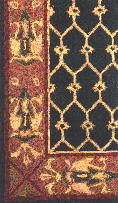Hooked Rugs

Hooked rugs had their start long ago and the art is centuries old, although just how old is debatable.
Theories abound regarding when and where the craft actually started. Some rug
hooking history books state that descendants of the ancient Egyptians made the
first hand-hooked rugs between the third and seventh centuries. Other historians
maintain that rug hooking originated in China or Europe. However, many
authorities now believe that rug hooking is America�s one indigenous folk art,
with the first hooked rugs appearing in Atlantic Canada and New England.
Hooked rugs weren't always popular. We do know for certain, however, that rug hooking experienced a surge of
popularity in the mid-nineteenth century in the New England states and the
Maritime provinces of Canada. Born initially out of necessity, hand-hooked rugs
were created by rural women to cover the bare floors of their homes. Later,
people began selling hand-hooked rugs, and cottage industries eventually sprang
up across the continent.
By the 1940�s, hooked rugs had become a well established hobby in the United
States and Canada. It has evolved into a popular means of personal expression as
well as a practical pastime. Hand-hooked rugs can be found in art galleries and
museums in New York City, Washington, DC, Toronto, and London, as well as in
local museums, libraries, and community centers across North America.
Hooked rug making uses a hand hook, similar in shape to a crochet hook to form a
looped pile from fabric strips or yarn on an even-weave base fabric. Punch
needles and speed hooks are also used to make hooked rugs, although the hooking
techniques and rug appearance differ. Rug hooking is not the same as
latch-hooking, which uses a hinged hook to form a knotted pile from short pieces
of yarn.
Hooked rugs are cheerful, handmade rugs produced using scraps of fabric or wool. Antiques - especially early North American hooked rugs - can be expensive, but their modern equivalents are much more reasonable.